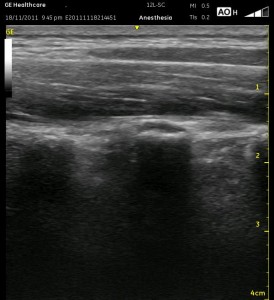PARAVERTEBRAL
 This is not a block that you should cut your teeth on, but it is the one that, in my opinion, has the most dramatic impact on the recovery of my patients. It is just awesome to speak to a patient after a thoracotomy that can take a deep breath and cough easily and is preoccupied with their neck being uncomfortable or sore from the trauma and akward bandaging of a central line. If this is what they are focusing on, you have made a real difference. Develop your skills; attain consistency in your technique and a ‘feel’ for some of the other blocks, then start reading up on this one. When it is time to embark on paravertebral blocks, you are going to discover a real excitement and satisfaction in what you do! The recovery of the patients stands out prominently to others, and you will know that you’ve overcome one of the biggest challenges out there in the nerve block world, plus the successful endpoint of ‘pleural bowing’ on ultrasound is really cool!
This is not a block that you should cut your teeth on, but it is the one that, in my opinion, has the most dramatic impact on the recovery of my patients. It is just awesome to speak to a patient after a thoracotomy that can take a deep breath and cough easily and is preoccupied with their neck being uncomfortable or sore from the trauma and akward bandaging of a central line. If this is what they are focusing on, you have made a real difference. Develop your skills; attain consistency in your technique and a ‘feel’ for some of the other blocks, then start reading up on this one. When it is time to embark on paravertebral blocks, you are going to discover a real excitement and satisfaction in what you do! The recovery of the patients stands out prominently to others, and you will know that you’ve overcome one of the biggest challenges out there in the nerve block world, plus the successful endpoint of ‘pleural bowing’ on ultrasound is really cool!
There are two basic approaches to do this block, transverse and oblique paramedian (OPM). Each approach can be done with either an in-plane or out-of-plane needle entry. Breaking into this block might be best done with a thoracotomy so that, worst case, a small pneumothorax does not make a scene. It is a rare occurrence that is likely to be managed conservatively anyway, but having a chest tube planned may afford you a little more security as you get started. Doing these for outpatient breast surgery is something to start on a little later.
If you want to start by doing these at the end of the surgery while the patient is still asleep, your choice of approach won’t be a concern. For blocks performed ahead of surgery (my recommendation for several reasons), it is practical to start looking at the OPM approach first which I will describe below. This is so that you are able to keep away from the surgeon’s field since the entry and securing of the catheter for the transverse approach will likely be too far lateral. Getting around this by just doing a single shot transverse paravertebral block ahead of surgery will not be doing your patient much of a favor either as it will not last long enough. If you do prefer to do your first blocks with the transverse approach at the end of the case, do your first ones on the surgeon’s last case of the day so you don’t feel rushed and you don’t throw-off your turn-over times. …
REGISTER for FREE to become a SUBSCRIBER or LOGIN HERE to see the full article!
See Also: Ultrasound Tip #2

